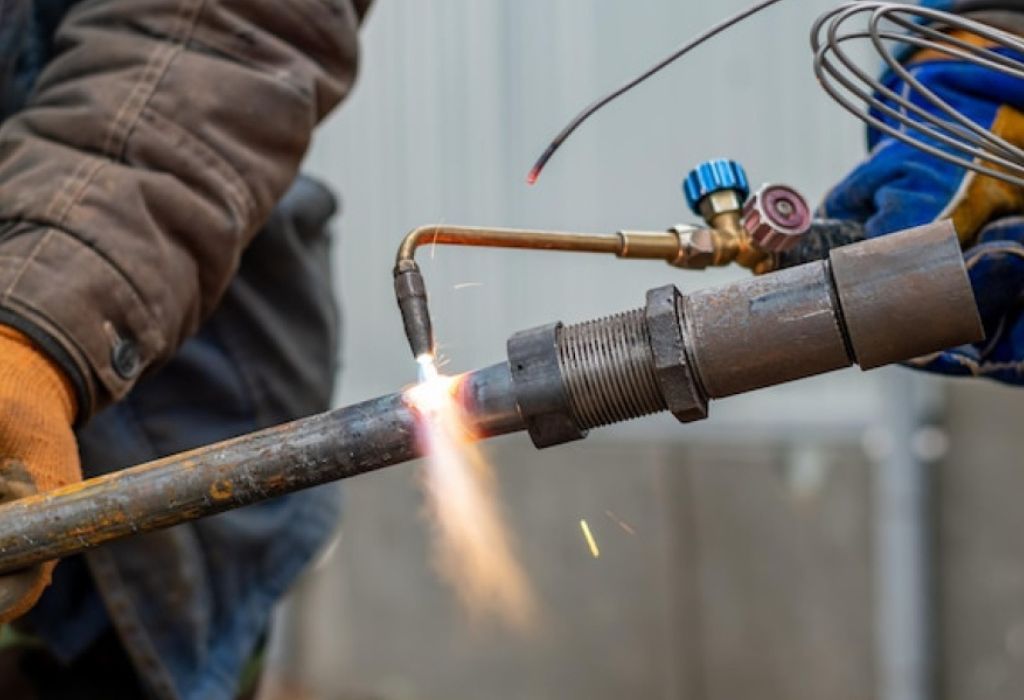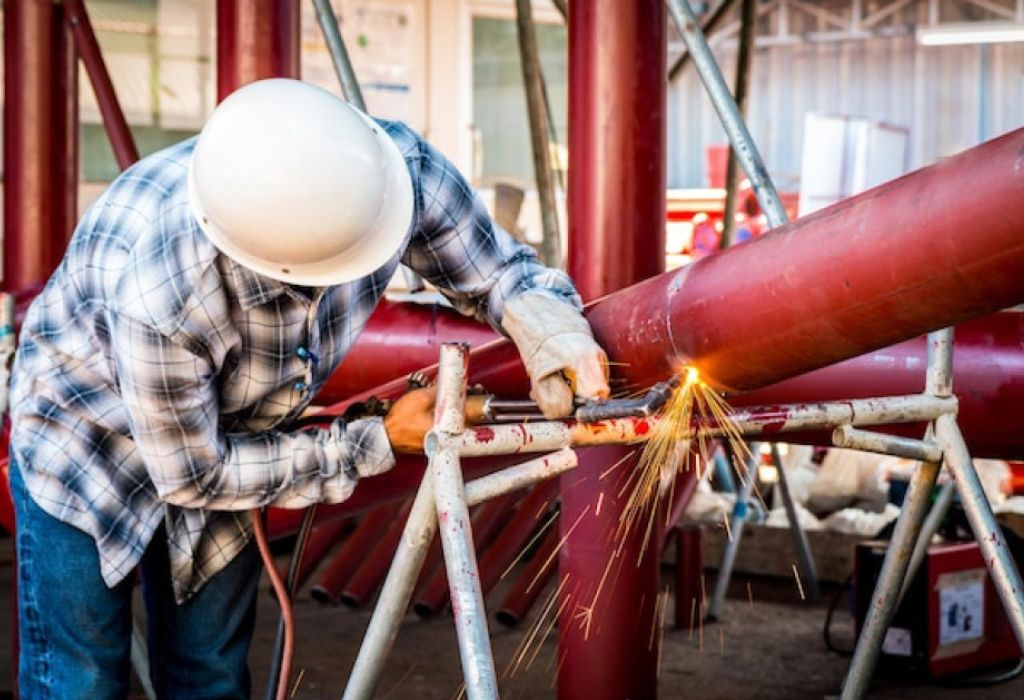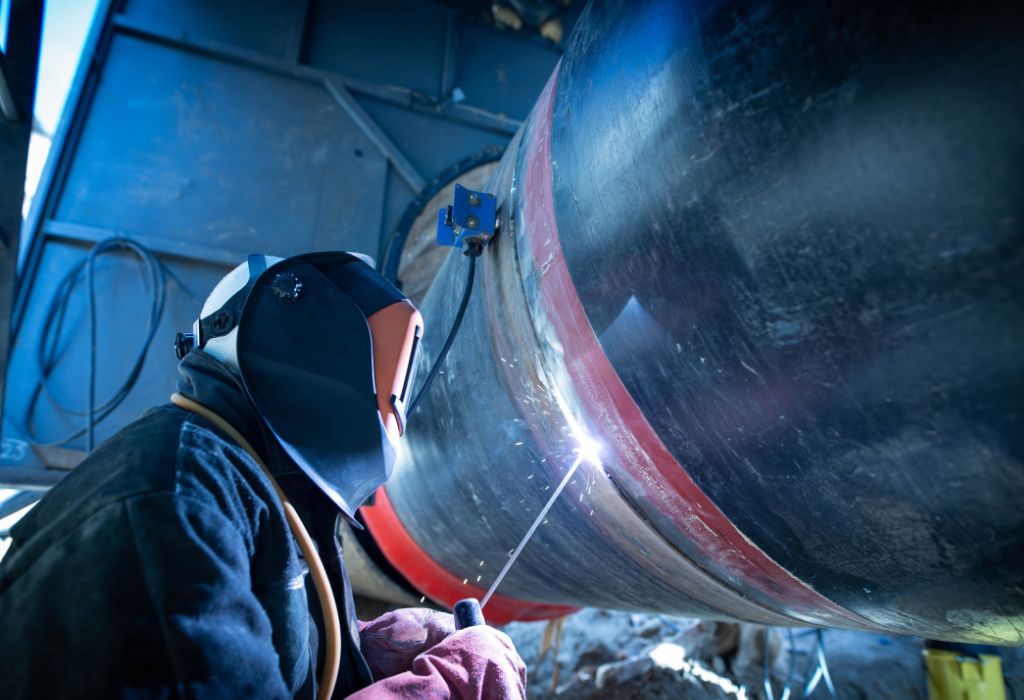Before dawn on a refinery jobsite, sparks light the air as welders crouch along a maze of pipe. To a newcomer, the first question is simple but vital: what does a pipe welder do each day to keep massive systems sealed and safe?
A pipe welder’s work looks straightforward, but every bead of molten metal carries responsibility. Pipes carry oil, gas, steam, and chemicals under immense pressure.
Each weld must meet strict codes and pass rigorous inspections, because a single flaw could shut down an entire operation.
At its core, pipe welding combines technical precision with physical endurance. Welders prepare bevels, align joints, and deposit root, hot, and cap passes that must hold for decades.
They work in power plants, refineries, pipelines, and shipyards, often in cramped spaces or extreme weather.
The job is regulated by recognized standards. API 1104 governs pipelines, while ASME Section IX covers boilers and pressure vessels.
Every welder proves skill through a Welder Performance Qualification (WPQ), and every project follows a Welding Procedure Specification (WPS).
These documents ensure consistency and traceability across thousands of joints.
Safety is inseparable from skill. In confined spaces, OSHA requires attendants, ventilation, and rescue plans to prevent tragedy.
The rules protect welders from fumes, fire, and the dangers of working in tanks, pits, or vaults (OSHA Confined Space).
Beyond the arc, inspectors verify welds using visual checks and nondestructive testing like radiography.
Passing these inspections turns a welded joint into a trusted connection that plants and pipelines depend on.
This guide explores the duties, tools, codes, and career outlook for pipe welders in 2025.
From first fit-up to final inspection, it reveals what the job really involves and why it remains one of the most critical trades in industry.
The Short Answer: What Does a Pipe Welder Do?

A pipe welder’s primary responsibility is to join and repair piping systems that carry oil, gas, steam, water, or chemicals. Their role goes far beyond striking an arc — it involves interpreting blueprints and isometric drawings, preparing pipe ends, ensuring correct alignment, and producing welds that meet strict codes and standards.
These welders follow detailed Welding Procedure Specifications (WPS), documenting every weld for traceability. Their work is frequently inspected by certified welding inspectors (CWI) through visual checks and nondestructive testing (NDT) such as radiography or ultrasonic testing. The ultimate goal is a safe, leak-proof connection that can withstand pressure, heat, and time.
Q&A:
Is a pipe welder the same as a pipefitter?
No. Pipefitters assemble and align pipe, while pipe welders fuse the joints permanently.
Where do pipe welders typically work?
In power plants, oil refineries, pipelines, shipyards, and industrial plants.
Do pipe welders need special qualifications?
Yes, they must pass performance tests based on codes such as API 1104 or ASME Section IX.
Are all welds inspected?
Critical welds are always inspected, often with visual and radiographic testing.
Is the job physically demanding?
Yes. Pipe welders
Daily Tasks and Workflow on a Pipe Crew
Every shift starts with reviewing drawings and confirming material specifications. Welders check pipe bevels, confirm fit-up gaps, and prepare joints for welding. Once aligned, they tack weld sections, then deposit root passes, followed by hot passes, fillers, and a final cap. Between each pass, welders clean and inspect the bead to prevent defects.
The work doesn’t end with the weld. Welders complete log sheets, sign weld maps, and ensure continuity records remain valid. Inspectors verify dimensions and fit-ups before authorizing the next stage of work.
Q&A:
What happens before the first weld?
Pipe is measured, beveled, aligned, and fit to specifications.
What is a root pass?
The first weld that establishes penetration and seals the joint’s interior.
Why are weld maps important?
They trace every weld for accountability and code compliance.
Who approves the joint?
Inspectors and quality control teams check fit-up and documentation.
What if a weld shows defects?
It must be repaired per code and retested before acceptance.
Welding Processes and Positions
Pipe welders use several welding processes depending on the job. In refineries and power plants, a common combination is GTAW (TIG) for the root and SMAW (stick) for fill and cap. Pipeline projects often use all-stick SMAW, while fabrication shops may rely on FCAW or GMAW (MIG) for efficiency.
Positions add another challenge. Welders must qualify in 5G and 6G positions, which simulate vertical, overhead, and angled joints. The 6G test is considered the most difficult, requiring mastery of every welding position in a single test.
Q&A:
Why use TIG for roots?
It provides clean penetration with minimal defects.
Is 6G the hardest test?
Yes, because it involves multiple positions on a fixed 45° pipe.
Do shops use MIG for pipe welding?
Yes, when allowed by procedure, especially for carbon steel.
What is interpass temperature?
The controlled heat between passes that ensures weld integrity.
Why preheat certain pipes?
To prevent cracking and hydrogen-induced failures.
Codes, Qualifications, and Paperwork
Pipe welders operate under strict codes. ASME Section IX governs boilers and pressure vessels, while API 1104 applies to pipelines. Each welder must complete a Welder Performance Qualification (WPQ), proving their ability to produce acceptable welds in a specified process, position, and material.
Continuity logs must be maintained, and any lapse may require retesting. Documentation such as WPS (Welding Procedure Specification) and PQR (Procedure Qualification Record) ensures consistency across the project.
Q&A:
What is a WPQ?
A test that certifies a welder’s ability to produce code-compliant welds.
How long is a qualification valid?
As long as continuity is maintained and essential variables remain unchanged.
Can a welder work across multiple codes?
Yes, but they must hold qualifications for each specific code.
Who keeps qualification records?
Employers and QC departments, though welders often carry copies.
What if a welder changes material or process?
They may need to retest under new conditions.
Safety First in Pipe Welding

Pipe welding involves high risk, particularly in confined spaces. OSHA mandates attendants, rescue provisions, and ventilation when welding inside tanks, vaults, or pits. Hot work permits are required in refineries and plants, ensuring hazards are controlled before welding begins.
Personal protective equipment includes helmets, gloves, flame-resistant clothing, and respiratory protection. Fire watches are mandatory in many industrial environments.
Q&A:
Why is confined-space welding dangerous?
It exposes welders to toxic fumes, heat, and limited escape routes.
Is an attendant always required?
Yes, for safety and rescue readiness.
What PPE is mandatory?
Helmets, FR clothing, gloves, and sometimes respirators.
Who authorizes hot work?
Site supervisors issue permits after hazard checks.
Do safety rules vary by site?
Yes, but OSHA standards provide the minimum baseline.
Inspection and Quality Control
Welds are inspected visually and often through nondestructive testing (NDT). Radiographic testing (RT) detects internal flaws, while ultrasonic testing (UT) checks weld depth and quality. Magnetic particle (MT) and liquid penetrant (PT) methods find surface cracks.
Final acceptance may involve hydrostatic or pressure testing of entire systems, ensuring welds hold under real-world stress.
Do all welds get radiography?
Not all, but critical ones almost always do.
What’s the role of NDT?
To ensure weld quality without destroying the pipe.
What is hydrotesting?
Filling a system with water under pressure to test for leaks.
Can minor defects be repaired?
Yes, per code, with proper documentation.
Who decides weld acceptance?
Certified inspectors using code criteria.
Work Environments: Field, Plant, and Shop
Pipe welders work in varied environments. Field welders travel to job sites, often pipelines, with long hours and outdoor conditions. Plant welders work in refineries, chemical plants, or power stations, requiring strict permits and safety rules. Shop welders fabricate pipe spools in controlled environments.
Each environment has pros and cons: fieldwork pays higher but demands travel; shop work is stable but often lower-paying; plant welding balances steady work with high safety standards.
Which pays the most?
Pipeline and shutdown work usually pay higher with overtime.
Is shop work better for beginners?
Yes, due to controlled conditions and lower risk.
Do plants have stricter rules?
Yes, due to hot work and safety systems.
Is travel required for all welders?
No, shop jobs rarely require travel.
Where is TIG most used?
In high-purity or stainless steel piping.
Tools and Equipment of Pipe Welders
Pipe welders rely on specialized tools: bevelers, grinders, purging kits, hi-lo alignment tools, clamps, and measuring gauges. Consumables include filler rods, electrodes, and shielding gases. Mobile welders often maintain rig trucks equipped with machines, leads, and safety gear.
What’s a hi-lo tool?
It measures internal pipe alignment.
Why carry purging kits?
For stainless steel and alloy welds requiring clean root passes.
Do welders provide their own tools?
Often yes, especially in fieldwork.
What’s a rig welder?
A mobile welder with a fully equipped truck.
Are grinders essential?
Yes, for cleaning and prepping between passes.
Career Path, Pay, and Outlook

According to the U.S. Bureau of Labor Statistics, welders earn a median salary of $51,000 annually, but pipe welders often exceed this average due to overtime and specialty work. Pipeline projects, refineries, and shutdowns can push annual income beyond $80,000–$100,000.
Career growth includes moving into foreman, inspector (CWI), QA/QC, or welding instructor roles. Unions and trade schools provide structured advancement paths.
Is demand steady?
Yes, maintenance and new infrastructure keep demand strong.
What’s the fastest way to increase pay?
Stacking code qualifications and accepting travel work.
What’s a logical next credential?
Certified Welding Inspector (CWI).
Do unions offer benefits?
Yes, structured training and healthcare.
Is travel required for higher pay?
Often yes, especially for pipeline projects.
Conclusion
So, what does a pipe welder do? They turn blueprints into leak-proof systems, ensuring that industries run safely and reliably. From reading drawings and preparing joints to welding under strict codes, documenting every bead, and passing rigorous inspections, pipe welders carry immense responsibility.
The career demands skill, discipline, and physical stamina — but it also offers strong pay, advancement, and pride in building the infrastructure that powers the world. For those ready to take the challenge, pipe welding remains one of the most respected trades in 2025.

I’m Darrell Julian, the founder, lead writer, and hands-on welding enthusiast behind ArcWeldingPro.com. With more than 15 years of real-world welding experience, I created this platform to share what I’ve learned in the field, in the shop, and in the heat of the arc.


